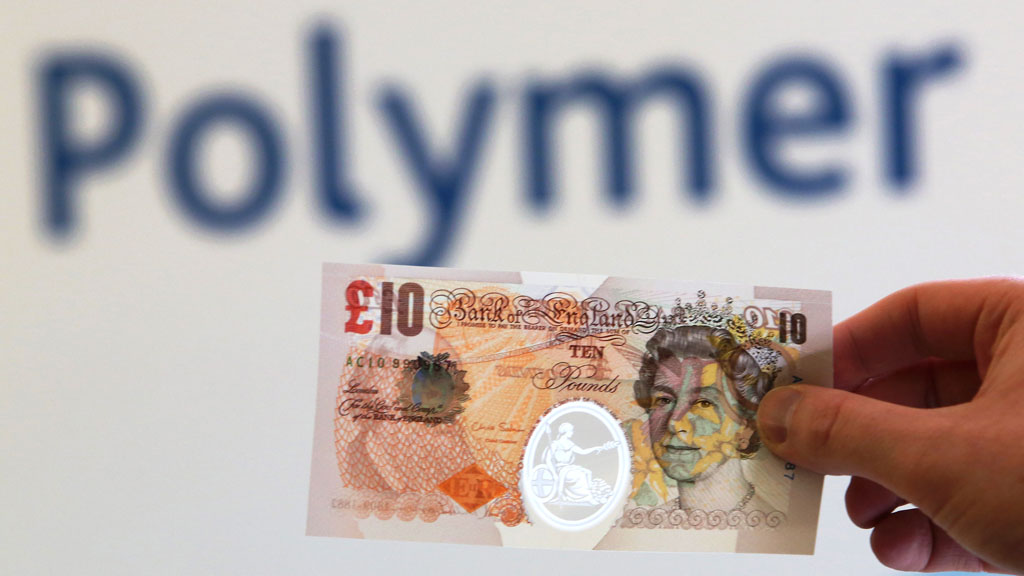Bank of England announces switch to plastic banknotes
Paper currency will disappear from circulation after 300 years, to be replaced by polymer notes. Changes will also be made to how famous faces are chosen to appear on notes.

The new notes will be slightly smaller, bringing Britain into line with other countries, but will “retain the familiar look of Bank of England banknotes, including the portrait of Her Majesty the Queen and a historical character”.
The first banknote made from polymer – a thin flexible plastic film – will be the £5 note featuring Sir Winston Churchill to be issued in 2016.
This will be followed around a year later by a polymer £10 note featuring the novelist Jane Austen.
The Bank has also announced it is to change the way historical figures are chosen to appear on notes, with the public given more of a say on whose face they want to see on British currency.
‘Cleaner and greener’
The Bank said polymer notes stay cleaner for longer than paper, can incorporate more advanced security features that make them difficult to counterfeit, and last two-and-a-half times longer than paper notes.
The new plastic fiver: I have illustrated the translucent quality of the polymer through use of my ear: pic.twitter.com/Do83cKfBfH
— Faisal Islam (@faisalislam) December 18, 2013
Plastic money is also more environmentally friendly and cheaper to manufacture in the long-term, the Bank added.
It said notes would be smaller overall but would continue to increase in size with face value, adding: “Bank of England notes are currently large compared with their international counterparts, making the largest denomination notes harder to fit into cash handling technology and less convenient for everyday use.
“Smaller notes will also reduce printing and storage costs.”
The current governor, Mark Carney, said: “Our polymer notes will combine the best of progress and tradition.
“They will be more secure from counterfeiting and more resistant to damage, while celebrating the history and tradition that is important both to the Bank and the nation as a whole.
“By consulting widely on the switch to polymer, and by putting in place a new process for selecting banknote characters with much more public input, we have reinforced the commitment to openness and transparency which lies at the heart of the Bank of England’s commitment to accountability.
“Together, these announcements ensure that our banknotes will remain both a national symbol and a source of national pride.”
Mr Carney brushed off fears that the notes would be damaged by heat, saying: “They don’t melt in the heat, unless it’s extreme heat. You have to get above boiling for it to actually happen.”

New process for choosing face of banknotes
The Bank has unveiled a new process for deciding which great Britons appear on notes, after it came under fire for failing to feature women.
Jane Austen was chosen as the face of the next £10 note after a high-profile campaign led by Caroline Criado-Perez.
Some 35,000 people signed an online petition calling for women to continue to be represented, after the last governor of the Bank of England, Mervyn King, announced that Churchill would replace social reformer Elizabeth Fry as the face of the £5 note.
The bank says a new advisory committee will come up with a theme to represented by historical figures “that have shaped British thought, innovation, leadership, values and society”.
The public will then have two months to nominate various people. Focus groups will sit down to narrow the field to a shortlist, with the final decision resting with the governor.
Plastic man @jonsnowC4 #c4news pic.twitter.com/pyNvxd0UKF
— Channel 4 News (@Channel4News) December 18, 2013
-
Latest news
-
Laughing Boy: New play tells the tragic tale of Connor Sparrowhawk5m

-
Sewage warning system allows some of worst test results to be left off rating system, analysis shows3m

-
Post Office inquiry: Former CEO didn’t like word “bugs” to refer to faulty IT system4m

-
Israeli soldier speaks out on war in Gaza12m

-
PM’s defence spending boost should be ‘celebrated’, says former Armed Forces Minister4m

-




